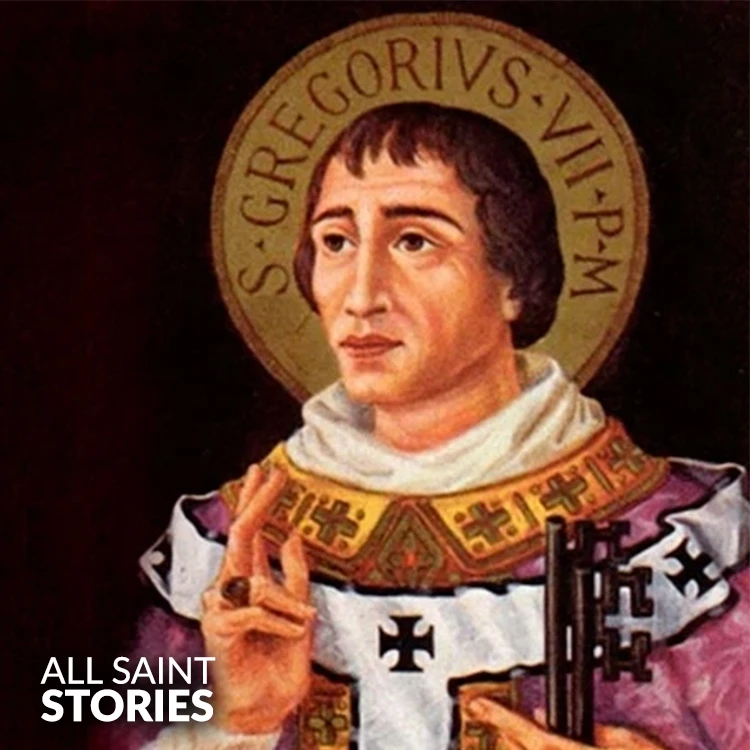"Saint Gregory VII, faithful servant of God, you worked tirelessly for the purity and unity of the Church. Intercede for us, that we may remain steadfast in faith, uphold truth, and live with humility and courage in our daily lives. May your example of dedication inspire us to always seek God's will. Through Christ our Lord. Amen."
ST. GREGORY VII POPE
ST. GREGORY VII POPE

St. Gregory VII, born Hildebrand of Sovana, was Pope from 1073 until his death in 1085. He is known for his reforms in the Church, including the enforcement of clerical celibacy and the assertion of papal supremacy over secular rulers. His efforts played a major role in the development of the Church's power in Europe.
Born around 1020 in Sovana, Italy, St. Gregory VII was initially known as Hildebrand. He became a Benedictine monk and later served as an advisor to several popes. His rise within the Church was due to his dedication to reforming and strengthening the authority of the papacy. He became pope in 1073 and was determined to assert papal supremacy over secular rulers, especially concerning the practice of investiture (the appointment of bishops by secular rulers).
His papacy was marked by intense conflict with the Holy Roman Emperor Henry IV, particularly over the issue of lay investiture. Gregory VII believed that only the pope had the authority to appoint bishops, while Emperor Henry IV claimed the right to do so. This conflict led to the famous "Walk to Canossa" in 1077, when Henry IV sought forgiveness from Gregory after being excommunicated.
St. Gregory VII also focused on enforcing clerical celibacy and eliminating simony (the selling of Church offices). His reforms significantly changed the relationship between the Church and secular rulers, and his actions strengthened the role of the pope in both religious and political matters.
St. Gregory VII passed away in 1085, and his feast day is celebrated on May 25. He was canonized by Pope Paul V in 1606. His papacy had a lasting impact on the structure and influence of the Roman Catholic Church.
Video Not Found
No images uploaded for this saint yet.
The information on this website is compiled from various trusted sources. While we aim for accuracy, some details may be incomplete or contain discrepancies.
If you notice any errors or have additional information about this saint, please use the form on the left to share your suggestions. Your input helps us improve and maintain reliable content for everyone.
All submissions are reviewed carefully, and your personal details will remain confidential. Thank you for contributing to the accuracy and value of this resource.
Credits & Acknowledgments
- Anudina Visudhar (Malayalam) – Life of Saints for Everyday
by Msgr. Thomas Moothedan, M.A., D.D. - Saint Companions for Each Day
by A. J. M. Mausolfe & J. K. Mausolfe - US Catholic (Faith in Real Life) – Informational articles
- Wikipedia – General reference content and images
- Anastpaul.com – Saint images and reflections
- Pravachaka Sabdam (Malayalam) – Saint-related content and insights
We sincerely thank these authors and platforms for their valuable contributions. If we have unintentionally missed any attribution, please notify us, and we will make the correction promptly.
If you have any suggestion about ST. GREGORY VII POPE
Your suggestion will help improve the information about this saint. Your details will not be disclosed anywhere.
© 2025 Copyright @ www.allsaintstories.com

 English
English
 Italian
Italian
 French
French
 Spanish
Spanish
 Malayalam
Malayalam
 Russian
Russian
 Korean
Korean
 Sinhala
Sinhala
 Japanese
Japanese
 Arabic
Arabic
 Portuguese
Portuguese
 Bantu
Bantu
 Greek
Greek
 German
German
 Dutch
Dutch
 Filipino
Filipino